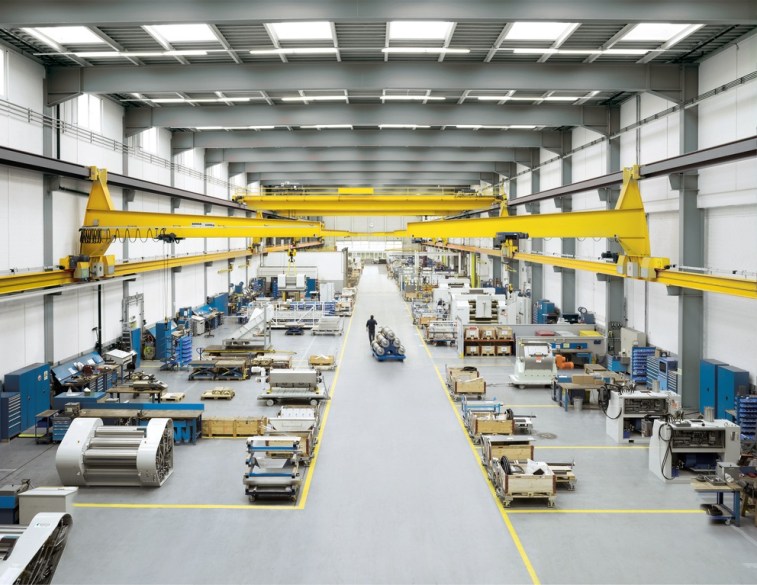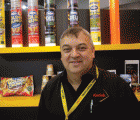
Whether transported by sea, rail, air or road, industrial goods have to be packaged well and securely so that they reach the user or consumer in immaculate condition. The goods often travel long distances to their final destination, over bumpy roads, on clattering rails or in rough seas. The packaged product has to withstand sharp braking and bumpy landings as well as climatic stressing and frequent reloading and repacking. In addition, packaging companies have to satisfy the rising expectations and specific needs of their customers: quality and first-class service are decisive in an industry marked by growing competition. Called for are packaging systems that ensure minimal waste and rapid re-equipping while of course running efficiently in terms of costs, energy and resources.
Genuine heavyweights
Special efforts are required for heavyweight items, i.e. goods with above-standard size or weight for transportation. For products weighing in at 100 tonnes or more, customised packaging is required. For the direct protection of the packaged contents, packagers make use of classical polyethylene or aluminium laminated films. Desiccants and chemical treatments with steam or contact phase inhibitors (using the volatile corrosion inhibitor) additionally inhibit corrosion, mould and other damage, for example due to condensation.
The overall packaging process for heavy goods is extremely challenging, as the loads can only be efficiently packed and loaded with the aid of heavy equipment like slewing cranes and other crane equipment. The vacuum specialist Schmalz has at its disposal special overhead cranes made of aluminium that score particularly highly with their favourable ratio of dead weight to payload.Ergonomic and safe handling during the packaging process is assured not only by pneumatic grab systems, but also by special vacuum lifting devices. These are noted for their high degree of versatility in action, although ‘vacuum handling is also noted for its speed’, says Dr Kurt Schmalz, managing partner of Schmalz.
Originally a razor blade manufacturer, the Black Forest firm has evolved since its founding in 1910 into one of the world’s leading suppliers of vacuum technology in the automation, handling and clamping sectors. Its VacuMaster swivelling lifting device is capable of effortlessly lifting metal sheets, wooden or plastic panels, drums, windows and glass panes weighing tonnes. Even heavy glass units can be loaded or packaged effortlessly and breakage-free by a single person.
Heavy equipment can be accompanied by an elaborate logistical exercise: as familiar from numerous TV reports, the transportation of heavy goods, often at night and under escort, sometimes necessitates the closure of whole roads.
Transport safety issues have to be settled in advance by everyone concerned, i.e. customer, manufacturer and haulier. Professional packaging planning is therefore indispensable when extra-large items are sent on their journey in wooden or iron crates.
Hazardous items
A different and, at the same time special, kind of packaging comes into play for the shipment of dangerous goods, i.e. substances, mixtures, and objects containing substances that present specific hazards during transport owing to their nature or physical or chemical properties. Fireworks, automotive seatbelt tensioners, hair spray, petrol and fertilisers as well as airbags and lithium batteries are all classified as dangerous goods.
The packages for such substances are subject to stringent legal regulations, based on the UN Recommendations on the Transport of Dangerous Goods. Worldwide, each dangerous goods package therefore has to be marked with a UN symbol followed by an alphanumeric code.
The growing popularity of electric vehicles sees lithium-ion batteries produced in large numbers worldwide. A suitable package for such dangerous goods has been designed by packaging the specialist DS Smith for the BMW Group.
Thanks to the special corrugated board interior, a total of twelve power storage units can be simply and quickly lowered with lifting gear into the transport boxes and secured. All of this achieved without folding or further padding. Unloading is just as convenient.
The batteries and padding are simply removed from the transport and storage package and, if desired, they are sent on individually or, for example, as a replacement parts shipment.
Pallets galore
For the handling of industrial goods, shipment pallets are perfectly adapted to needs as regards load-bearing capacity, quality and economy.
But pallets can differ enormously. These practical helpers that are capable of carrying up to 1500 kilos are available in numerous versions on the market.
Two-way or four-way pallets, disposable, reusable, heavy-duty or special-purpose pallets are just some of the possible types.
One distinguishing feature is the material. The majority are made of wood, and usually of the types of wood available in the country of manufacture. Alternatively, plastic and metal pallets are employed – or pallets made of corrugated board. For the familiar Euro-pallet, birch, pine and spruce timbers are most frequently used. Depending on the stressing from the product itself, climate and handling, reusable pallets are capable of withstanding as many as fifteen trips.
The American equivalent of the Euro-pallet is the GMA pallet. Measuring 40 101.6 x 121.92 cm, it is slightly larger. For freight transport by ship, special industrial pallets are therefore required. These conform to the American system of measurement and can be loaded trouble-free into ISO containers.
Pal-box is the name of the practical pallet container made of corrugated board. The shipping container from the paper and packaging specialists of the London-based Mondi Group literally stands on its own feet. On the corrugated board box available in different sizes, the pallet feet are attached to the base. stac-pac, Mondi’s heavy-duty storage container made of die-cut heavy-duty corrugated board, is designed to handle the heaviest goods. Reinforcing wooden planks are fixed with reusable clips to the exterior for extra-high stability.
Longer life solutions
To improve the robustness and durability of shipping carriers made of mixed materials, special coatings can be used. The further-developed Elastocoat C spray system that seals hybrid pallets of plastic and medium-density fibreboard (MDF) for extra strength and makes additional priming superfluous comes from German chemicals giant BASF. The hybrid MDF pallets sealed with Elastocoat C are said to be not only more robust, but also some 25 per cent lighter than traditional pallets. Gorm Carsting, PU Systems, explains: “The Elastocoat C spray system seals pallet surfaces efficiently,
Comment below to have your say on this story.
If you have a news story or tip-off, get in touch at editorial@sprinter.com.au.
Sign up to the Sprinter newsletter

